Button TOYOTA YARIS CROSS 2021 Owners Manual
[x] Cancel search | Manufacturer: TOYOTA, Model Year: 2021, Model line: YARIS CROSS, Model: TOYOTA YARIS CROSS 2021Pages: 650, PDF Size: 132.86 MB
Page 22 of 650
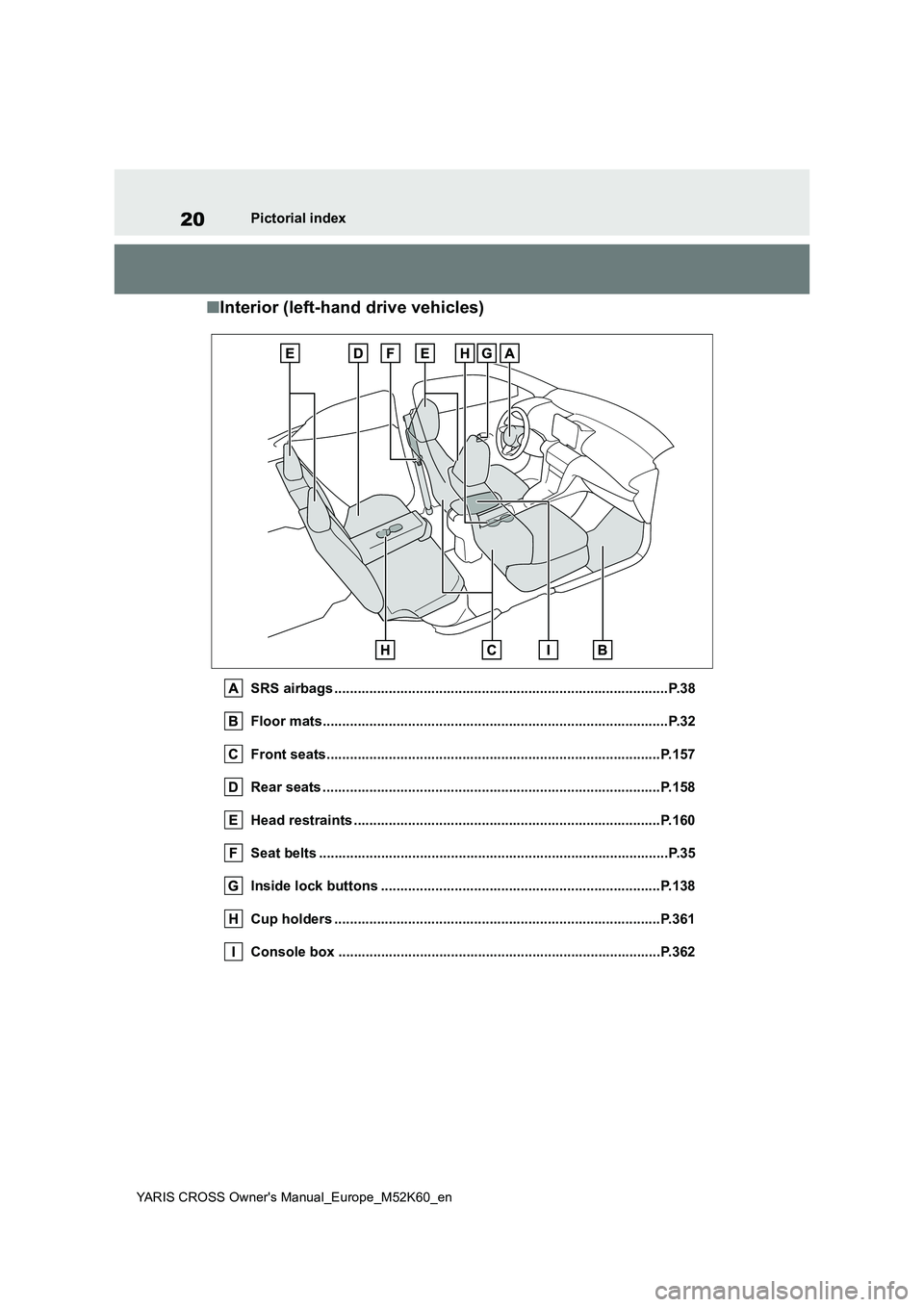
20
YARIS CROSS Owner's Manual_Europe_M52K60_en
Pictorial index
Ō¢ĀInterior (left-hand drive vehicles)
SRS airbags ......................................................................................P.38
Floor mats..................................................... ....................................P.32
Front seats.................................................... ..................................P.157
Rear seats ..................................................... ..................................P.158
Head restraints ................................................ ...............................P.160
Seat belts ..................................................... .....................................P.35
Inside lock buttons ............................................ ............................P.138
Cup holders .................................................... ................................P.361
Console box .................................................... ...............................P.362
Page 23 of 650
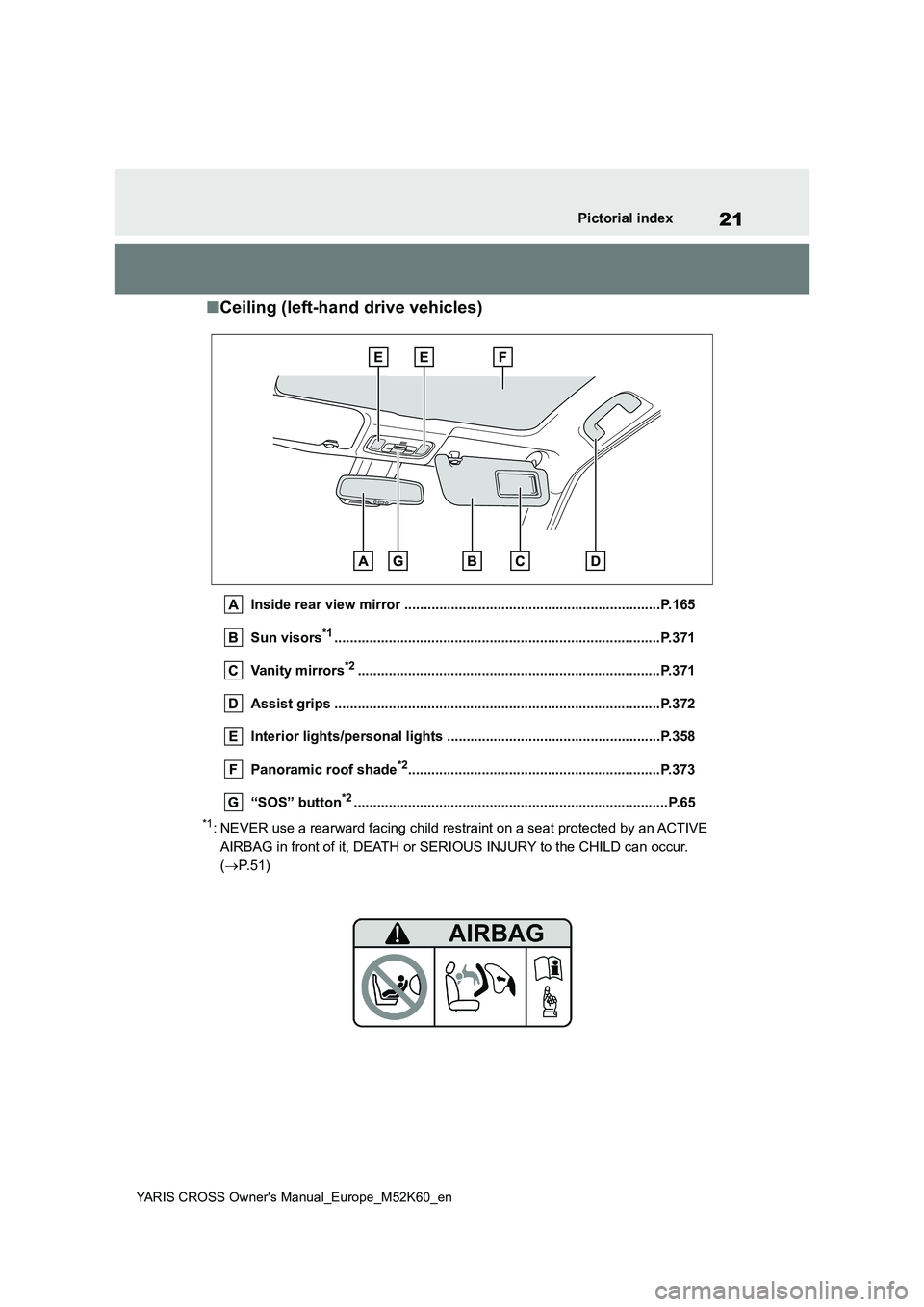
21
YARIS CROSS Owner's Manual_Europe_M52K60_en
Pictorial index
Ō¢ĀCeiling (left-hand drive vehicles)
Inside rear view mirror ..................................................................P.165
Sun visors*1............................................................... .....................P.371
Vanity mirrors*2............................................................... ...............P.371
Assist grips ................................................... .................................P.372
Interior lights/personal lights ................................ .......................P.358
Panoramic roof shade*2............................................................... ..P.373
ŌĆ£SOSŌĆØ button*2............................................................... ..................P.65
*1: NEVER use a rearward facing child restraint on a seat protected by an ACTIVE
AIRBAG in front of it, DEATH or SERIOUS INJURY to the CHILD can occur.
( ’é«P.51)
Page 30 of 650
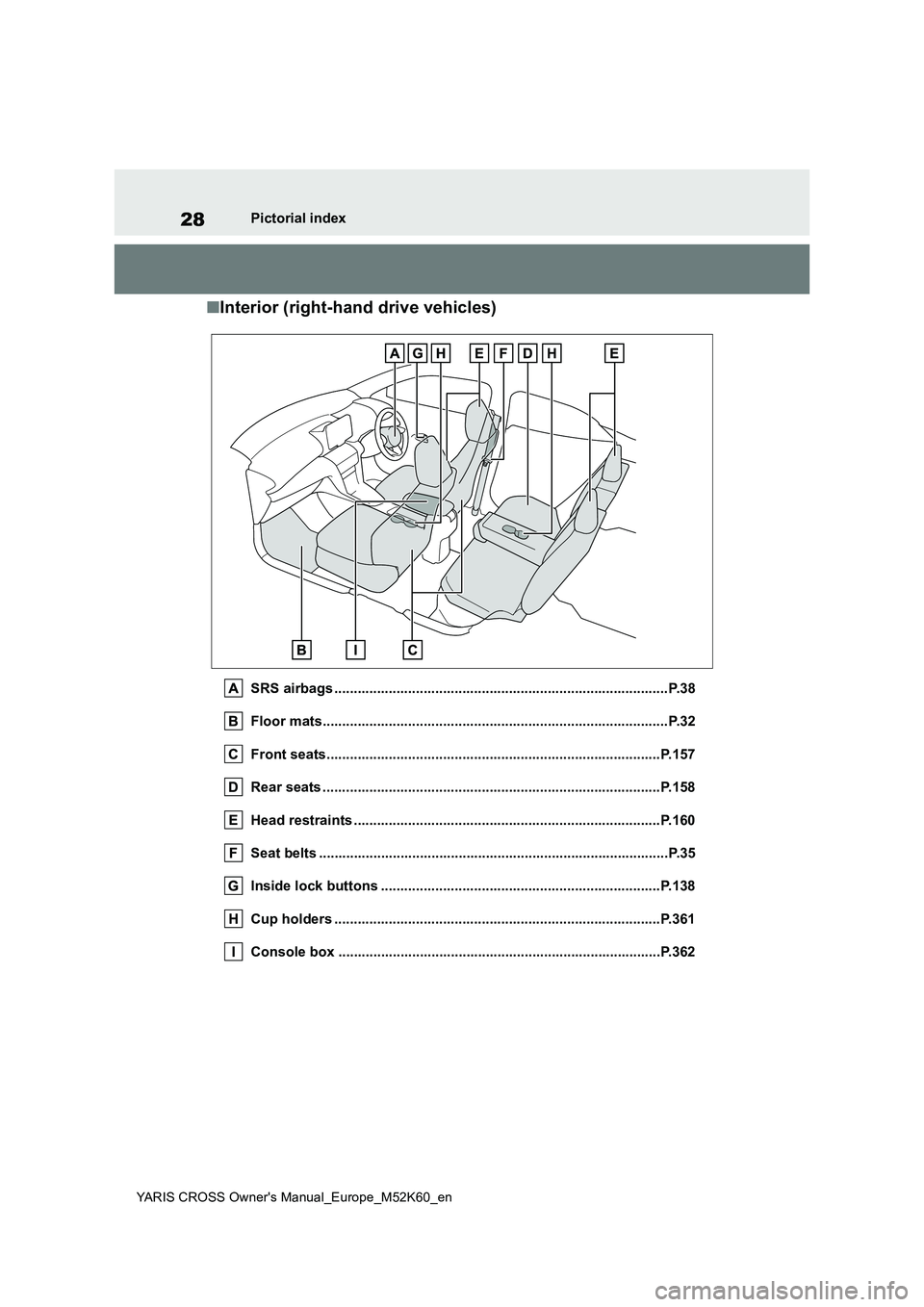
28
YARIS CROSS Owner's Manual_Europe_M52K60_en
Pictorial index
Ō¢ĀInterior (right-hand drive vehicles)
SRS airbags ......................................................................................P.38
Floor mats..................................................... ....................................P.32
Front seats.................................................... ..................................P.157
Rear seats ..................................................... ..................................P.158
Head restraints ................................................ ...............................P.160
Seat belts ..................................................... .....................................P.35
Inside lock buttons ............................................ ............................P.138
Cup holders .................................................... ................................P.361
Console box .................................................... ...............................P.362
Page 31 of 650
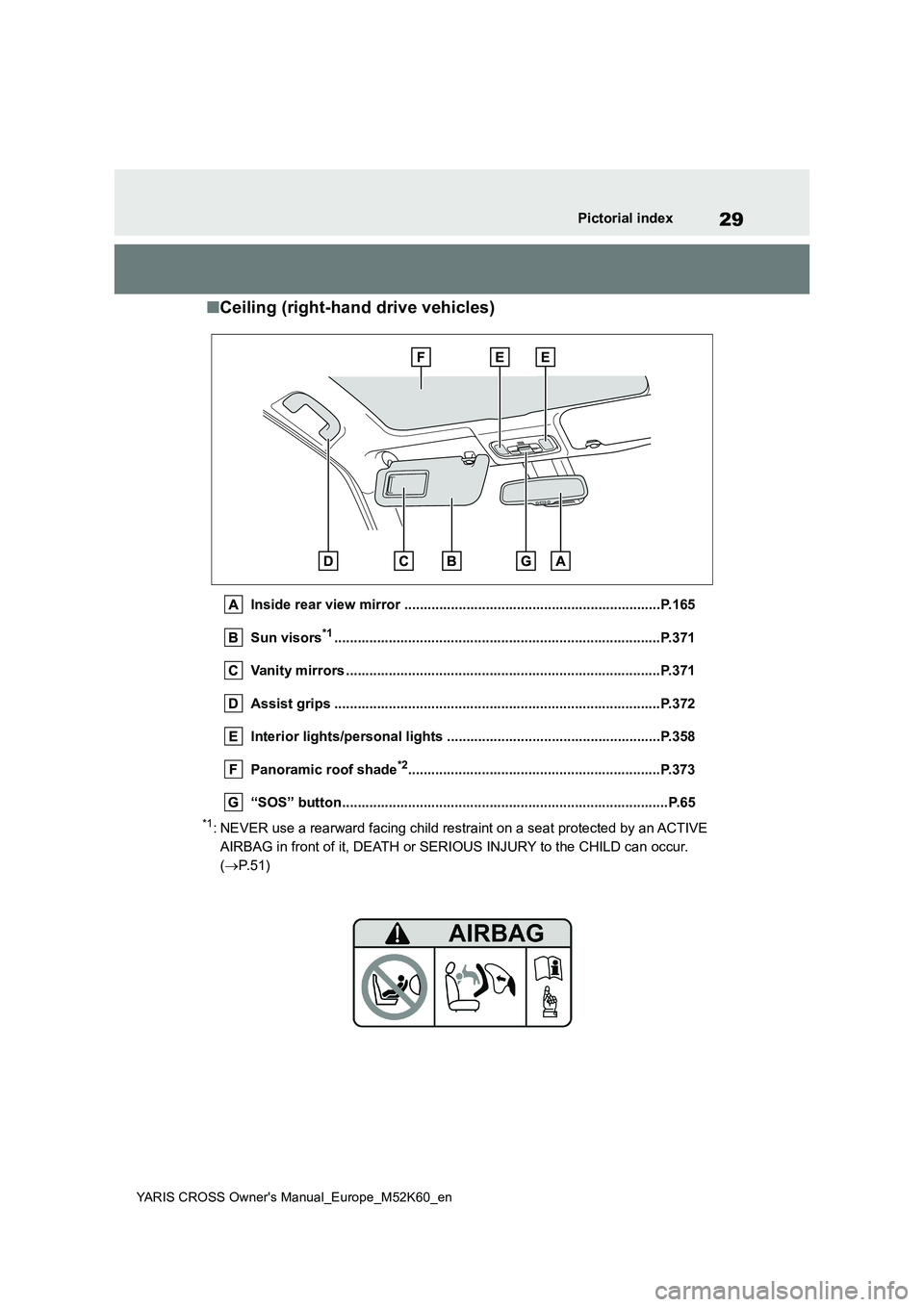
29
YARIS CROSS Owner's Manual_Europe_M52K60_en
Pictorial index
Ō¢ĀCeiling (right-hand drive vehicles)
Inside rear view mirror ..................................................................P.165
Sun visors*1............................................................... .....................P.371
Vanity mirrors ................................................. ................................P.371
Assist grips ................................................... .................................P.372
Interior lights/personal lights ................................ .......................P.358
Panoramic roof shade*2............................................................... ..P.373
ŌĆ£SOSŌĆØ button................................................... .................................P.65
*1: NEVER use a rearward facing child restraint on a seat protected by an ACTIVE
AIRBAG in front of it, DEATH or SERIOUS INJURY to the CHILD can occur.
( ’é«P.51)
Page 39 of 650
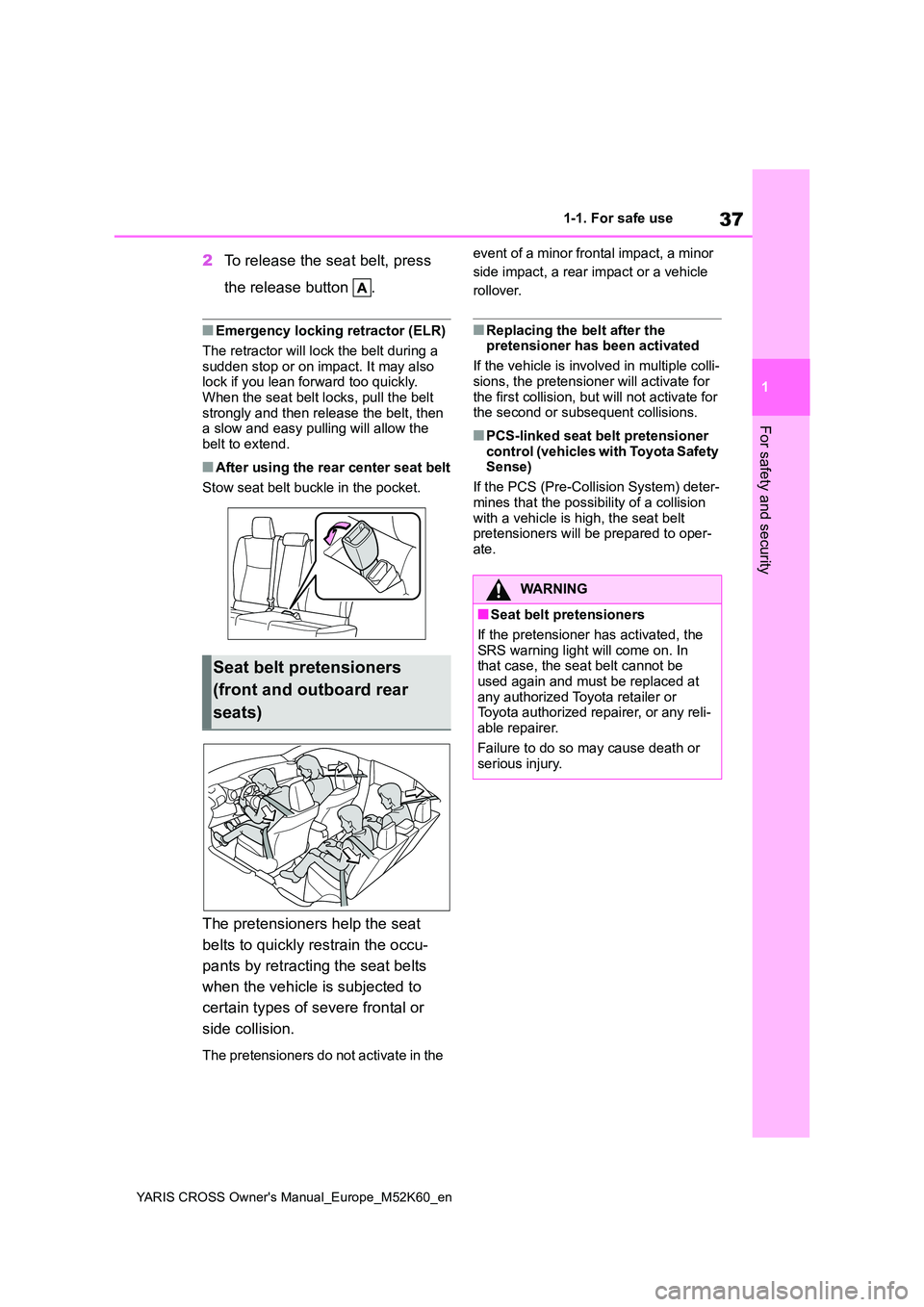
37
1
YARIS CROSS Owner's Manual_Europe_M52K60_en
1-1. For safe use
For safety and security
2To release the seat belt, press
the release button .
Ō¢ĀEmergency locking retractor (ELR)
The retractor will lock the belt during a sudden stop or on impact. It may also lock if you lean forward too quickly.
When the seat belt locks, pull the belt strongly and then release the belt, then a slow and easy pulling will allow the
belt to extend.
Ō¢ĀAfter using the rear center seat belt
Stow seat belt buckle in the pocket.
The pretensioners help the seat
belts to quickly restrain the occu-
pants by retracting the seat belts
when the vehicle is subjected to
certain types of severe frontal or
side collision.
The pretensioners do not activate in the
event of a minor frontal impact, a minor
side impact, a rear impact or a vehicle
rollover.
Ō¢ĀReplacing the belt after the pretensioner has been activated
If the vehicle is involved in multiple colli-
sions, the pretensioner will activate for the first collision, but will not activate for the second or subsequent collisions.
Ō¢ĀPCS-linked seat belt pretensioner
control (vehicles with Toyota Safety Sense)
If the PCS (Pre-Collision System) deter-
mines that the possibility of a collision with a vehicle is high, the seat belt pretensioners will be prepared to oper-
ate.
Seat belt pretensioners
(front and outboard rear
seats)
WARNING
Ō¢ĀSeat belt pretensioners
If the pretensioner has activated, the SRS warning light will come on. In that case, the seat belt cannot be
used again and must be replaced at any authorized Toyota retailer or Toyota authorized repairer, or any reli-
able repairer.
Failure to do so may cause death or serious injury.
Page 42 of 650
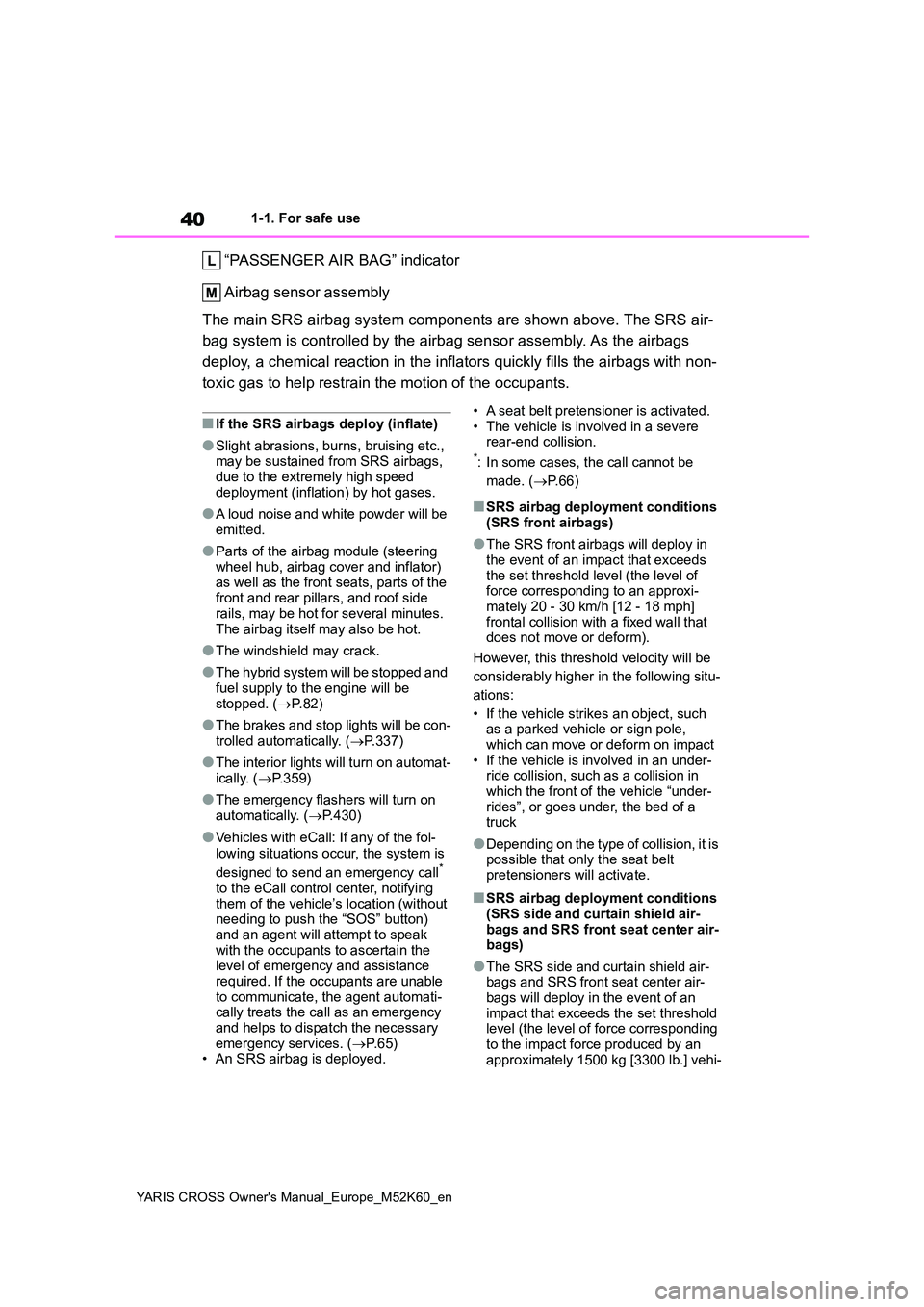
40
YARIS CROSS Owner's Manual_Europe_M52K60_en
1-1. For safe use
ŌĆ£PASSENGER AIR BAGŌĆØ indicator
Airbag sensor assembly
The main SRS airbag system components are shown above. The SRS air-
bag system is controlled by the airbag sensor assembly. As the airbags
deploy, a chemical reaction in the inflators quickly fills the airbags with non-
toxic gas to help restrain the motion of the occupants.
Ō¢ĀIf the SRS airbags deploy (inflate)
ŌŚÅSlight abrasions, burns, bruising etc., may be sustained from SRS airbags,
due to the extremely high speed deployment (inflation) by hot gases.
ŌŚÅA loud noise and white powder will be emitted.
ŌŚÅParts of the airbag module (steering wheel hub, airbag cover and inflator) as well as the front seats, parts of the
front and rear pillars, and roof side rails, may be hot for several minutes.
The airbag itself may also be hot.
ŌŚÅThe windshield may crack.
ŌŚÅThe hybrid system will be stopped and fuel supply to the engine will be
stopped. ( ’é«P.82)
ŌŚÅThe brakes and stop lights will be con-
trolled automatically. ( ’é«P.337)
ŌŚÅThe interior lights will turn on automat-
ically. ( ’é«P.359)
ŌŚÅThe emergency flashers will turn on
automatically. ( ’é«P.430)
ŌŚÅVehicles with eCall: If any of the fol-
lowing situations occur, the system is
designed to send an emergency call* to the eCall control center, notifying
them of the vehicleŌĆÖs location (without needing to push the ŌĆ£SOSŌĆØ button) and an agent will attempt to speak
with the occupants to ascertain the level of emergency and assistance required. If the occupants are unable
to communicate, the agent automati- cally treats the call as an emergency and helps to dispatch the necessary
emergency services. ( ’é«P.65) ŌĆó An SRS airbag is deployed.
ŌĆó A seat belt pretensioner is activated. ŌĆó The vehicle is involved in a severe rear-end collision.*: In some cases, the call cannot be
made. ( ’é«P. 6 6 )
Ō¢ĀSRS airbag deployment conditions
(SRS front airbags)
ŌŚÅThe SRS front airbags will deploy in
the event of an impact that exceeds the set threshold level (the level of force corresponding to an approxi-
mately 20 - 30 km/h [12 - 18 mph] frontal collision with a fixed wall that does not move or deform).
However, this threshold velocity will be
considerably higher in the following situ-
ations:
ŌĆó If the vehicle strikes an object, such as a parked vehicle or sign pole, which can move or deform on impact
ŌĆó If the vehicle is involved in an under- ride collision, such as a collision in which the front of the vehicle ŌĆ£under-
ridesŌĆØ, or goes under, the bed of a truck
ŌŚÅDepending on the type of collision, it is possible that only the seat belt pretensioners will activate.
Ō¢ĀSRS airbag deployment conditions
(SRS side and curtain shield air- bags and SRS front seat center air-bags)
ŌŚÅThe SRS side and curtain shield air-bags and SRS front seat center air-
bags will deploy in the event of an impact that exceeds the set threshold level (the level of force corresponding
to the impact force produced by an approximately 1500 kg [3300 lb.] vehi-
Page 63 of 650
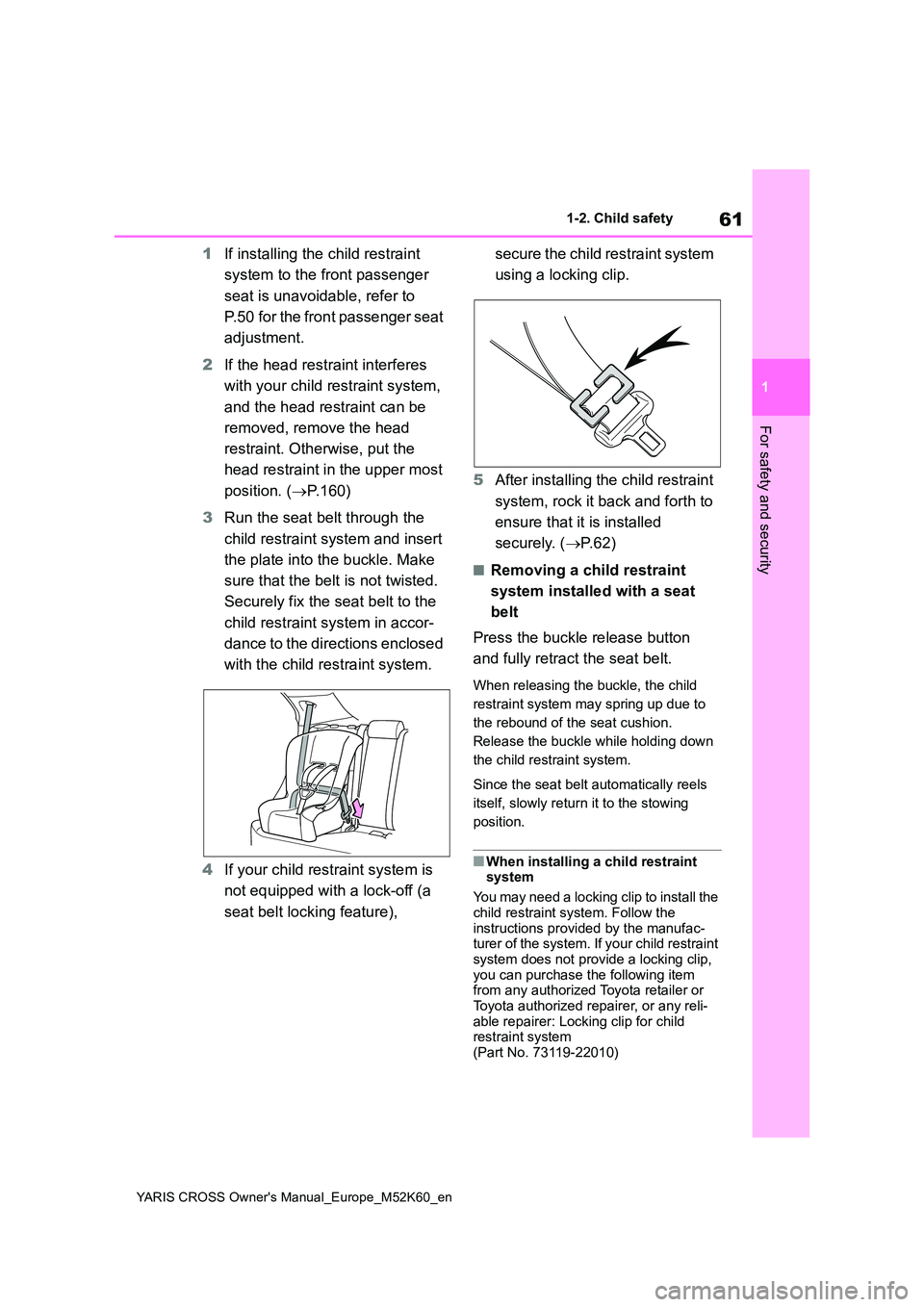
61
1
YARIS CROSS Owner's Manual_Europe_M52K60_en
1-2. Child safety
For safety and security
1If installing the child restraint
system to the front passenger
seat is unavoidable, refer to
P.50 for the front passenger seat
adjustment.
2 If the head restraint interferes
with your child restraint system,
and the head restraint can be
removed, remove the head
restraint. Otherwise, put the
head restraint in the upper most
position. ( ’é«P.160)
3 Run the seat belt through the
child restraint system and insert
the plate into the buckle. Make
sure that the belt is not twisted.
Securely fix the seat belt to the
child restraint system in accor-
dance to the directions enclosed
with the child restraint system.
4 If your child restraint system is
not equipped with a lock-off (a
seat belt locking feature),
s e c u r e t h e c h i l d r e s t r a i n t s y s t e m
using a locking clip.
5 After installing the child restraint
system, rock it back and forth to
ensure that it is installed
securely. ( ’é«P. 6 2 )
Ō¢ĀRemoving a child restraint
system installed with a seat
belt
Press the buckle release button
and fully retract the seat belt.
When releasing the buckle, the child
restraint system may spring up due to
the rebound of the seat cushion.
Release the buckle while holding down
the child restraint system.
Since the seat belt automatically reels
itself, slowly return it to the stowing
position.
Ō¢ĀWhen installing a child restraint system
You may need a locking clip to install the
child restraint system. Follow the instructions provided by the manufac-turer of the system. If your child restraint
system does not provide a locking clip, you can purchase the following item from any authorized Toyota retailer or
Toyota authorized repairer, or any reli- able repairer: Locking clip for child restraint system
(Part No. 73119-22010)
Page 67 of 650
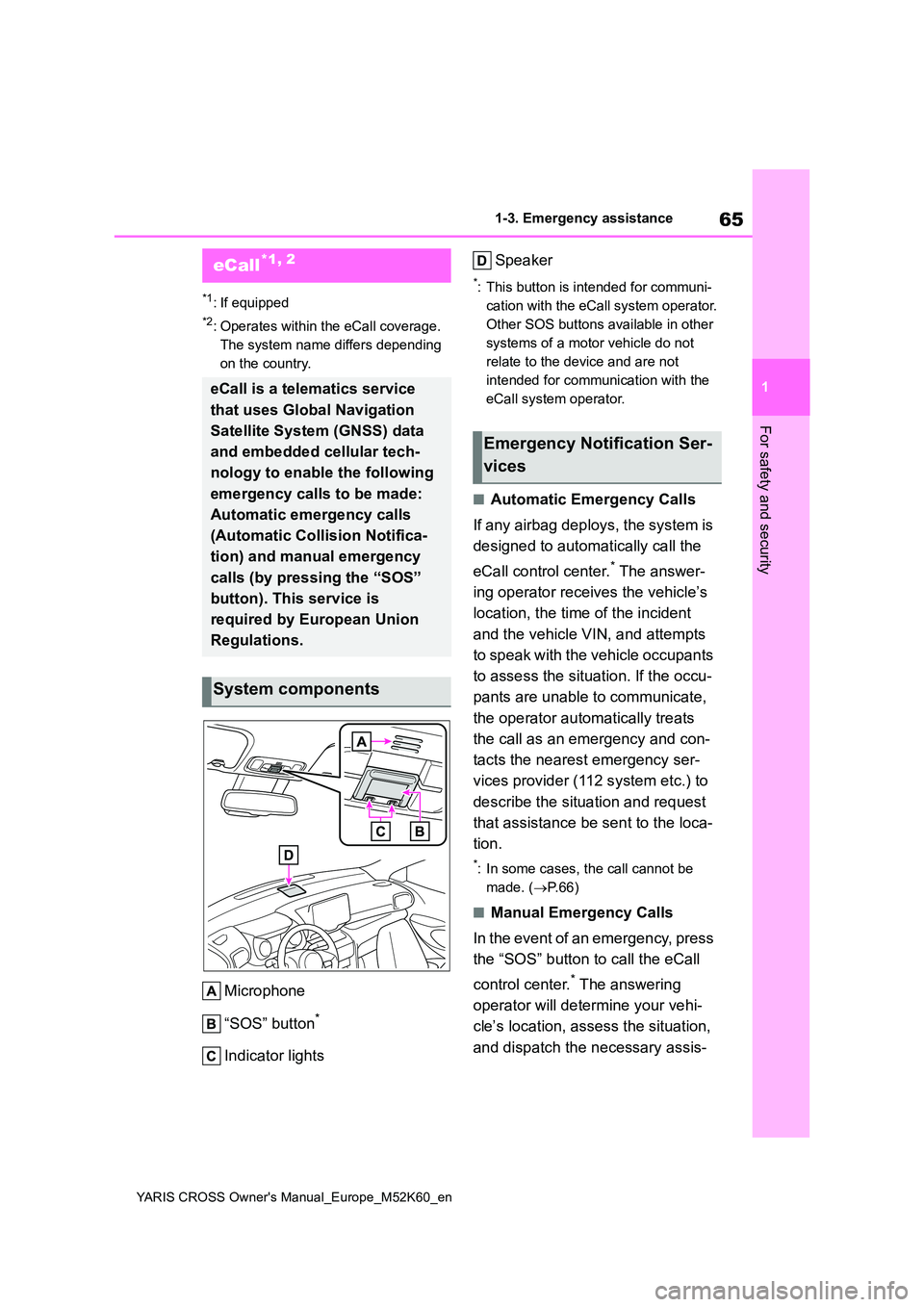
65
1
YARIS CROSS Owner's Manual_Europe_M52K60_en
1-3. Emergency assistance
For safety and security
1-3.Emerg ency as sista nce
*1: If equipped
*2: Operates within the eCall coverage.
The system name differs depending
on the country.
Microphone
ŌĆ£SOSŌĆØ button*
Indicator lights
Speaker
*: This button is intended for communi-
cation with the eCall system operator.
Other SOS buttons available in other
systems of a motor vehicle do not
relate to the device and are not
intended for communication with the
eCall system operator.
Ō¢ĀAutomatic Emergency Calls
If any airbag deploys, the system is
designed to automatically call the
eCall control center.* The answer-
ing operator receives the vehicleŌĆÖs
location, the time of the incident
and the vehicle VIN, and attempts
to speak with the vehicle occupants
to assess the situation. If the occu-
pants are unable to communicate,
the operator automatically treats
the call as an emergency and con-
tacts the nearest emergency ser-
vices provider (112 system etc.) to
describe the situation and request
that assistance be sent to the loca-
tion.
*: In some cases, the call cannot be
made. ( ’é«P. 6 6 )
Ō¢ĀManual Emergency Calls
In the event of an emergency, press
the ŌĆ£SOSŌĆØ button to call the eCall
control center.* The answering
operator will determine your vehi-
cleŌĆÖs location, assess the situation,
and dispatch the necessary assis-
eCall*1, 2
eCall is a telematics service
that uses Global Navigation
Satellite System (GNSS) data
and embedded cellular tech-
nology to enable the following
emergency calls to be made:
Automatic emergency calls
(Automatic Collision Notifica-
tion) and manual emergency
calls (by pressing the ŌĆ£SOSŌĆØ
button). This service is
required by European Union
Regulations.
System components
Emergency Notification Ser-
vices
Page 68 of 650
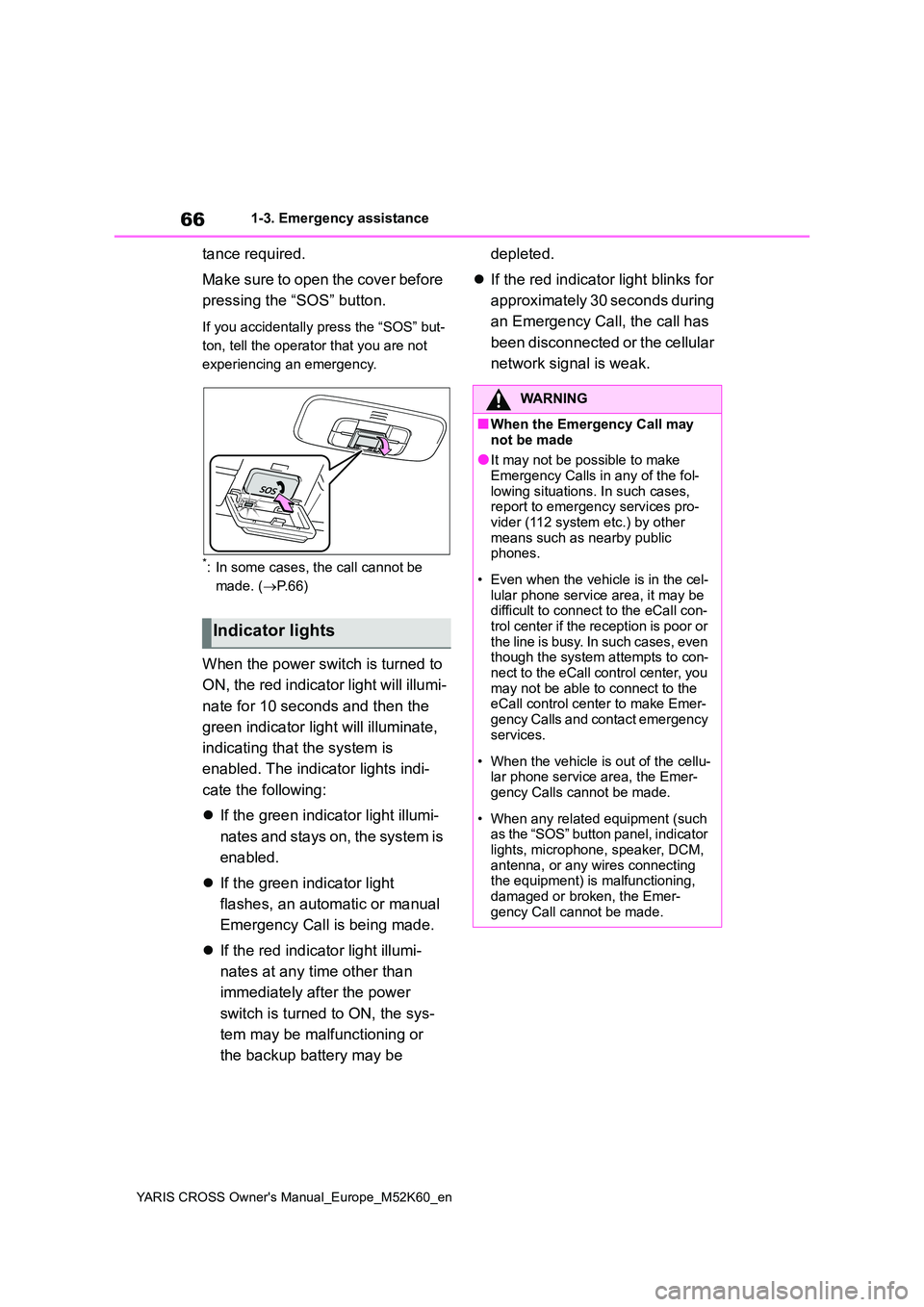
66
YARIS CROSS Owner's Manual_Europe_M52K60_en
1-3. Emergency assistance
tance required.
Make sure to open the cover before
pressing the ŌĆ£SOSŌĆØ button.
If you accidentally press the ŌĆ£SOSŌĆØ but-
ton, tell the operator that you are not
experiencing an emergency.
*: In some cases, the call cannot be
made. ( ’é«P. 6 6 )
When the power switch is turned to
ON, the red indicator light will illumi-
nate for 10 seconds and then the
green indicator light will illuminate,
indicating that the system is
enabled. The indicator lights indi-
cate the following:
’ü¼ If the green indicator light illumi-
nates and stays on, the system is
enabled.
’ü¼ If the green indicator light
flashes, an automatic or manual
Emergency Call is being made.
’ü¼ If the red indicator light illumi-
nates at any time other than
immediately after the power
switch is turned to ON, the sys-
tem may be malfunctioning or
the backup battery may be
depleted.
’ü¼ If the red indicator light blinks for
approximately 30 seconds during
an Emergency Call, the call has
been disconnected or the cellular
network signal is weak.
Indicator lights
WARNING
Ō¢ĀWhen the Emergency Call may
not be made
ŌŚÅIt may not be possible to make Emergency Calls in any of the fol-
lowing situations. In such cases, report to emergency services pro-vider (112 system etc.) by other
means such as nearby public phones.
ŌĆó Even when the vehicle is in the cel- lular phone service area, it may be difficult to connect to the eCall con-
trol center if the reception is poor or the line is busy. In such cases, even though the system attempts to con-
nect to the eCall control center, you may not be able to connect to the eCall control center to make Emer-
gency Calls and contact emergency services.
ŌĆó When the vehicle is out of the cellu- lar phone service area, the Emer-gency Calls cannot be made.
ŌĆó When any related equipment (such as the ŌĆ£SOSŌĆØ button panel, indicator
lights, microphone, speaker, DCM, antenna, or any wires connecting the equipment) is malfunctioning,
damaged or broken, the Emer- gency Call cannot be made.
Page 98 of 650
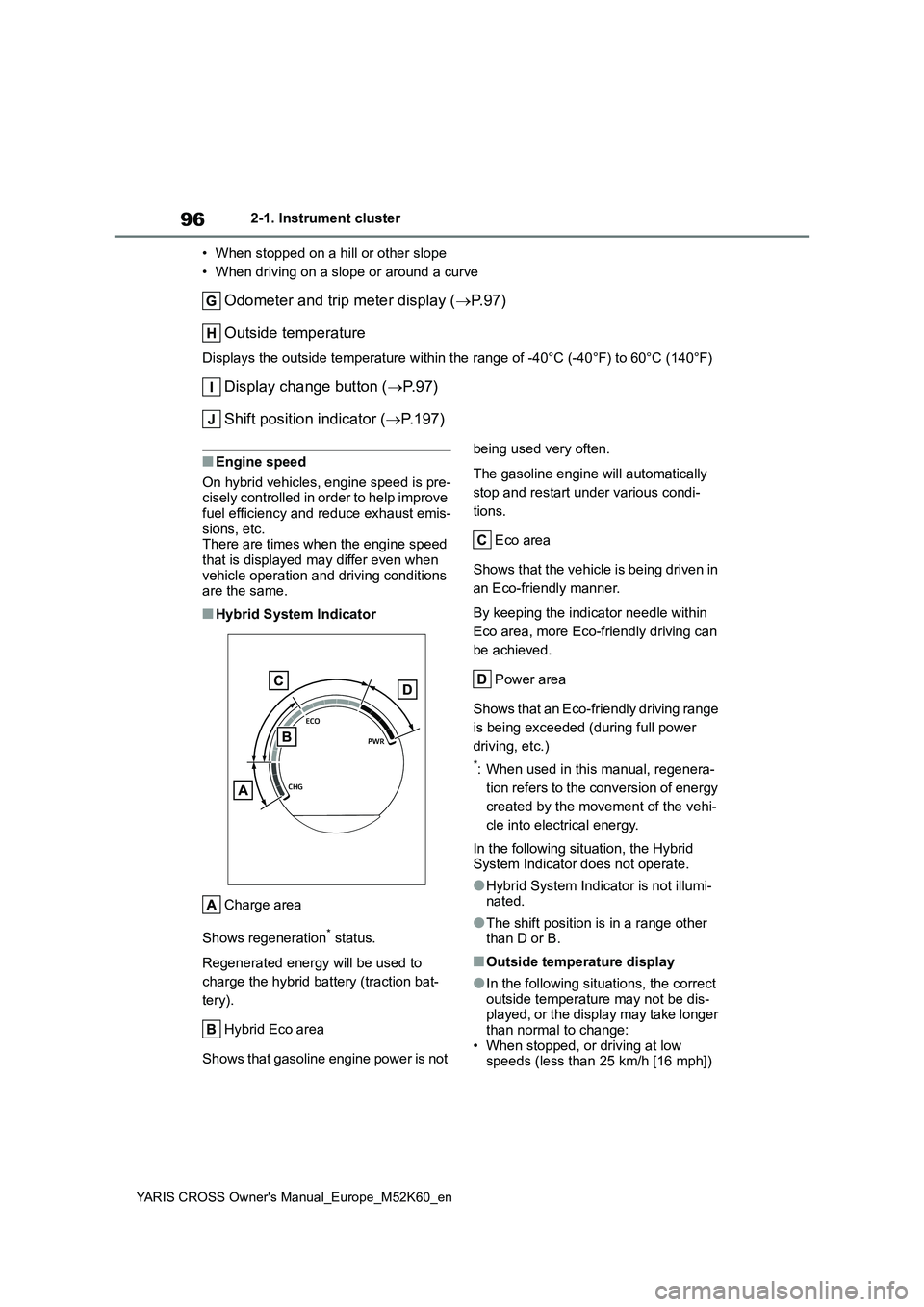
96
YARIS CROSS Owner's Manual_Europe_M52K60_en
2-1. Instrument cluster
ŌĆó When stopped on a hill or other slope
ŌĆó When driving on a slope or around a curve
Odometer and trip meter display ( ’é«P. 9 7 )
Outside temperature
Displays the outside temperature within the range of -40┬░C (-40 ┬░F) to 60┬░C (140┬░F)
Display change button (’é«P. 9 7 )
Shift position indicator ( ’é«P.197)
Ō¢ĀEngine speed
On hybrid vehicles, engine speed is pre- cisely controlled in order to help improve fuel efficiency and reduce exhaust emis-
sions, etc. There are times when the engine speed that is displayed may differ even when
vehicle operation and driving conditions are the same.
Ō¢ĀHybrid System Indicator
Charge area
Shows regeneration* status.
Regenerated energy will be used to
charge the hybrid battery (traction bat-
tery).
Hybrid Eco area
Shows that gasoline engine power is not
being used very often.
The gasoline engine will automatically
stop and restart under various condi-
tions.
Eco area
Shows that the vehicle is being driven in
an Eco-friendly manner.
By keeping the indicator needle within
Eco area, more Eco-friendly driving can
be achieved.
Power area
Shows that an Eco-friendly driving range
is being exceeded (during full power
driving, etc.)
*: When used in this manual, regenera-
tion refers to the conversion of energy
created by the movement of the vehi-
cle into electrical energy.
In the following situation, the Hybrid System Indicator does not operate.
ŌŚÅHybrid System Indicator is not illumi-nated.
ŌŚÅThe shift position is in a range other than D or B.
Ō¢ĀOutside temperature display
ŌŚÅIn the following situations, the correct outside temperature may not be dis-played, or the display may take longer
than normal to change: ŌĆó When stopped, or driving at low speeds (less than 25 km/h [16 mph])